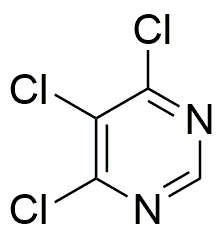4,5,6-Trichloropyrimidine is widely utilized in research focused on:
- Pharmaceutical Development: This compound serves as a key intermediate in the synthesis of various pharmaceuticals, particularly in the development of antiviral and anticancer agents, enhancing the efficacy of treatments.
- Agricultural Chemicals: It is used in the formulation of herbicides and fungicides, providing effective solutions for crop protection and pest management, which is crucial for increasing agricultural productivity.
- Material Science: The compound is employed in the creation of specialized polymers and resins, contributing to the development of materials with enhanced durability and chemical resistance.
- Biochemical Research: Researchers utilize it as a building block for synthesizing nucleoside analogs, aiding in studies related to genetic material and cellular processes.
- Analytical Chemistry: It is used as a reference standard in various analytical methods, ensuring accuracy and reliability in the detection and quantification of similar compounds.
General Information
Properties
Safety and Regulations
Applications
4,5,6-Trichloropyrimidine is widely utilized in research focused on:
- Pharmaceutical Development: This compound serves as a key intermediate in the synthesis of various pharmaceuticals, particularly in the development of antiviral and anticancer agents, enhancing the efficacy of treatments.
- Agricultural Chemicals: It is used in the formulation of herbicides and fungicides, providing effective solutions for crop protection and pest management, which is crucial for increasing agricultural productivity.
- Material Science: The compound is employed in the creation of specialized polymers and resins, contributing to the development of materials with enhanced durability and chemical resistance.
- Biochemical Research: Researchers utilize it as a building block for synthesizing nucleoside analogs, aiding in studies related to genetic material and cellular processes.
- Analytical Chemistry: It is used as a reference standard in various analytical methods, ensuring accuracy and reliability in the detection and quantification of similar compounds.
Documents
Safety Data Sheets (SDS)
The SDS provides comprehensive safety information on handling, storage, and disposal of the product.
Product Specification (PS)
The PS provides a comprehensive breakdown of the product’s properties, including chemical composition, physical state, purity, and storage requirements. It also details acceptable quality ranges and the product's intended applications.
Certificates of Analysis (COA)
Search for Certificates of Analysis (COA) by entering the products Lot Number. Lot and Batch Numbers can be found on a product’s label following the words ‘Lot’ or ‘Batch’.
*Catalog Number
*Lot Number
Certificates Of Origin (COO)
This COO confirms the country where the product was manufactured, and also details the materials and components used in it and whether it is derived from natural, synthetic, or other specific sources. This certificate may be required for customs, trade, and regulatory compliance.
*Catalog Number
*Lot Number
Safety Data Sheets (SDS)
The SDS provides comprehensive safety information on handling, storage, and disposal of the product.
DownloadProduct Specification (PS)
The PS provides a comprehensive breakdown of the product’s properties, including chemical composition, physical state, purity, and storage requirements. It also details acceptable quality ranges and the product's intended applications.
DownloadCertificates of Analysis (COA)
Search for Certificates of Analysis (COA) by entering the products Lot Number. Lot and Batch Numbers can be found on a product’s label following the words ‘Lot’ or ‘Batch’.
*Catalog Number
*Lot Number
Certificates Of Origin (COO)
This COO confirms the country where the product was manufactured, and also details the materials and components used in it and whether it is derived from natural, synthetic, or other specific sources. This certificate may be required for customs, trade, and regulatory compliance.


